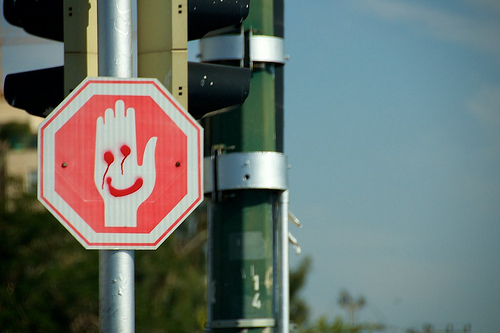Have you ever received an email from a stranger, and it started with, “Dear Sir or Madam…” and you felt 30 years older just reading it? Well, we’re here to save you from making the same mistake by providing you a list of five things to ban from your future email correspondences.

(Photo Credit: photolini/Flickr)
It’s understandable that you’d want to maintain a certain level of professionalism when sending correspondences, but what is considered excessive when it comes to email etiquette? A good rule of thumb is to use natural language and assume that your email will be read to both your friends and Sir Richard Branson. In other words, you want to be able to convey your message without sounding too uptight or like a prude, but also be able to uphold a level of professionalism so you don’t sound like you’re talking to one of your buddies about last weekend’s radicalness.
Here are five things to steer clear of when sending off your next work email.
1. Emoticons ;p
Emoticons can be tricky because they seem to be used so often in everyday conversations online and in text, but be sure to only use a “winky face” when you’re writing to someone that you’re 100 percent sure is A-OK with it. Plus, “;)” and “:p” can be easily misconstrued or misinterpreted when sending it to the opposite sex in a professional setting. Therefore, just refrain from ever including emoticons to your superiors or outside professionals.
2. Excessive use of punctuation …!?!?… and “special formatting”
One exclamation point is sufficient to get the point across that you’re excited about something. Also, try and keep your use of exclamation points to a minimum, because it becomes a bit excessive after two or three in one email.
Bonus tip: Quotation marks and special formatting don’t need “to be used” on every “other” word because the reader will sound like a “robot” when reading the “email” and probably just give up on trying to read the rest. So, use special formatting and punctuation minimally and only when needed — you don’t want to be that guy.
3. Casual or vague salutations
“To Whom it May Concern” – Usually this salutation is used when the recipient’s gender and/or name is unknown, but you should do some investigative work and try your best to figure out who will be receiving your email. Use the wealth of information on the internet and social media networks to help you out.
“Dear Sir or Madam” – We’re in 2013, not the 1800s, so try not to use this phrase and make the 25-year-old HR recruiter feel like she is 95 years old. Again, do a little dirty work to figure out who you’re addressing first, so that you can use their actual name rather than an informal (and somewhat offensive) designation.
“Hey, you” – Yeah, that’s an obvious one right there.
4. Loose language or swearing
It’s not the best idea to send your boss an email that begins with, “What’s up, dude…” because you’ll probably be taken for an idiot, unless your boss is a close family member or friend. Always address colleagues and your superiors, especially, by their given names rather than “dude” or “girl.”
Swearing is another thing that should never appear in any professional correspondence, even if you are joking around or trying to look cool. Many companies nowadays have zero-tolerance policies against employees using profanities or inappropriate language while on the clock, so save your trucker’s mouth for outside the workplace.
5. Informal email sign-offs
For some other email don’ts, check out Fast Company’s post here.
Tell Us What You Think
Do you have anything to add to the work email don’ts list? If so, share your input on Twitter or in the comments section below.
Leave a Reply